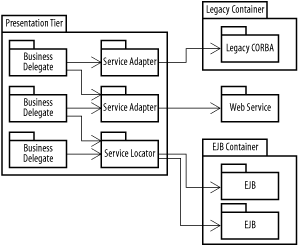Accessing Remote Services
Business delegates are great for providing local code with access to business resources, whether the resources themselves are local or not. For local resources the data lives on the same server—maybe even in the same JVM—as the business delegate. In these situations, connecting to the data is not a huge concern. J2EE, however, is designed to handle much more complicated scenarios. An enterprise J2EE deployment typically involves resources that are distributed between multiple servers. To fulfill requests, the servers hosting the presentation tier may need to communicate with application servers, messaging middleware servers, database servers, and legacy IS systems. Finding all these servers and maintaining the various connections can quickly complicate otherwise simple business delegates.
Since the work of connecting is not central to the business delegate, it is often beneficial to build a separate object that the delegates can use to access remote services. The Service Adapter and Service Locator patterns describe ways to do this, the former for non-J2EE business services and the latter primarily for EJBs. Figure 9-5 shows how the service locator and service adapter act as intermediaries between the business delegates and business services.
 |
The Service Adapter Pattern
A business delegate might make use of several ...
Get J2EE Design Patterns now with the O’Reilly learning platform.
O’Reilly members experience books, live events, courses curated by job role, and more from O’Reilly and nearly 200 top publishers.

